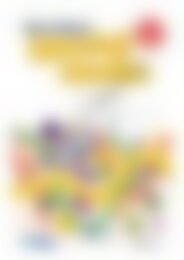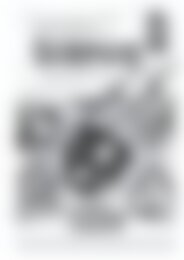RIC-6836 Maths Essentials - Geometry and Measurement 2 (Ages 11-15)
Create successful ePaper yourself
Turn your PDF publications into a flip-book with our unique Google optimized e-Paper software.
<strong>Geometry</strong> <strong>Measurement</strong> Chance <strong>and</strong> data<br />
<strong>Maths</strong><br />
Units of<br />
measurement<br />
Length<br />
Area<br />
mm<br />
cm<br />
m<br />
km<br />
mm 2<br />
cm 2<br />
m 2<br />
km 2<br />
ha<br />
Capacity<br />
mL<br />
L<br />
kL<br />
Mass<br />
mg<br />
g<br />
kg<br />
t<br />
Temperature<br />
millimetre<br />
centimetre<br />
metre<br />
kilometre<br />
square millimetre<br />
square centimetre<br />
square metre<br />
square kilometre<br />
hectare<br />
millilitre<br />
litre<br />
kilolitre<br />
milligram<br />
gram<br />
kilogram<br />
tonne<br />
°C degree Celsius<br />
°F degree Fahrenheit<br />
K<br />
kelvin<br />
Capacity<br />
To calculate the capacity<br />
of a container, calculate its<br />
volume <strong>and</strong> then convert to<br />
units of capacity.<br />
1 cm 3 = 1 mL<br />
1000 cm 3 = 1 L<br />
1 m 3 = 1000 L = 1 kL<br />
Density<br />
Density is the mass per unit<br />
volume.<br />
density =<br />
mass<br />
volume<br />
d = m V<br />
Units: g/cm 3 or kg/m 3<br />
<strong>Measurement</strong><br />
Rules <strong>and</strong> formulas<br />
Composite shapes<br />
A composite shape is a combination<br />
of other shapes. The area can be<br />
calculated by adding the area of the<br />
individual shapes.<br />
Area formulas<br />
Circle<br />
Circumference:<br />
= 2 r or x d<br />
diameter<br />
radius<br />
Area:<br />
= r 2<br />
Parallelogram<br />
A = bh<br />
Area = base x height<br />
Rectangular<br />
prism<br />
b<br />
V = A x H<br />
V = (l x w) x H<br />
side<br />
Triangle<br />
h<br />
Perimeter:<br />
= s + s + s<br />
Area:<br />
= 1 2<br />
x (b x h)<br />
base<br />
Triangular<br />
prism<br />
For example:<br />
height<br />
The surface area (TSA)<br />
is the total area of the outside surfaces of three-dimensional shapes.<br />
Cube<br />
TSA = 6l 2<br />
Rectangular prism<br />
TSA = 2(lw + hw + hl)<br />
Volume of prisms<br />
Volume of non-prisms<br />
Cone<br />
V = 1 3 AH<br />
= 1 3 r2 H<br />
Cylinder<br />
TSA = 2 r(r + h)<br />
Cone<br />
TSA = r 2 + rs<br />
Some solids are irregular <strong>and</strong> require specifi c formulas.<br />
Trapezium<br />
V = A x H<br />
V = b x h x H<br />
2<br />
Square pyramid<br />
1 2<br />
Area = Area 1 + Area 2 + Area 3<br />
Rectangle<br />
Perimeter:<br />
= 2 x (l + w)<br />
Area:<br />
= l x w<br />
length<br />
Cylinder<br />
3<br />
Sphere<br />
TSA = 4 r 2<br />
Square-based pyramid<br />
TSA = b 2 + 2bh<br />
V = 1 3 AH<br />
= 1 3 lwH Sphere<br />
a<br />
A = 1 2<br />
(a + b) x h<br />
Area = sum of two<br />
parallel sides<br />
x height, halved<br />
b<br />
h<br />
width<br />
Presenting data<br />
Pie<br />
graph<br />
Portions of<br />
a circle are<br />
used to show<br />
a whole<br />
divided into<br />
parts.<br />
Line graph<br />
A graph which has a vertical <strong>and</strong><br />
a horizontal axis <strong>and</strong> is formed by<br />
joining points with straight lines<br />
to represent data.<br />
Box-<strong>and</strong>-whisker plot<br />
Chance <strong>and</strong> data<br />
Histogram<br />
Is used to represent small or large<br />
amounts of data.<br />
For example:<br />
The box shows the median, upper <strong>and</strong> lower quartiles (<strong>and</strong> interquartile range).<br />
The ends of the whiskers show the lowest <strong>and</strong> highest values in the data (the<br />
range).<br />
Multiple bar graph<br />
Can be used to graphically<br />
compare two sets of data.<br />
Fixed data is placed on the<br />
horizontal axis.<br />
Statistics<br />
Sport played<br />
No. of<br />
students<br />
Soccer 34<br />
T-ball 8<br />
Swimming 50<br />
Netball 34<br />
football 24<br />
basketball 50<br />
Bar graph<br />
A graph which represents information regarding frequency of outcomes<br />
using bar lengths. The graph has a vertical <strong>and</strong> horizontal axis. The bars<br />
may be vertical or horizontal.<br />
Stem-<strong>and</strong>-leaf plots<br />
Arranges data to show its shape <strong>and</strong><br />
distribution. It may be used to calculate the<br />
mean, median <strong>and</strong> mode of a set of data.<br />
Each data value is split into a ‘stem’ <strong>and</strong> a<br />
‘leaf’. The leaf represents the unit digit <strong>and</strong><br />
the stem represents all others.<br />
23, 25, 21<br />
32, 35<br />
47, 49<br />
represented as:<br />
stem leaf<br />
2<br />
3<br />
4<br />
3 5 1<br />
2 5<br />
7 9<br />
Scatter graph<br />
Used to compare two sets of data to determine if there is a<br />
correlation between them. The dots on the scatter graph represent<br />
the data points for each person. A straight line of best fi t may be<br />
drawn.<br />
NOTE<br />
Scatter graphs may<br />
show:<br />
weak strong<br />
positive relationships<br />
weak strong<br />
negative relationships<br />
no relationship<br />
V = A x H<br />
Collecting <strong>and</strong> classifying information <strong>and</strong> data from a sample for a specific purpose.<br />
V = ( r 2 ) x H<br />
convenience sampling<br />
median<br />
Choosing a sample the most costeffi<br />
cient/easiest way.<br />
are arranged in order of size. Where there is no<br />
The middle measurement, or score, when items<br />
middle score, the mean of the two central scores<br />
cumulative frequency<br />
is taken.<br />
Number of results below a given value.<br />
For example:<br />
discrete variables<br />
<strong>11</strong>, 12, 13, 14, <strong>15</strong>, 16, 16, 16, 18, 19<br />
V = 4 Variables that can be measured exactly.<br />
The median is<br />
3 r3 interquartile range (IQR)<br />
<strong>15</strong> + 16<br />
= <strong>15</strong>.5<br />
Range of 50% of a distribution. Elimates mode 2<br />
extreme values.<br />
IQR = upper quartile – lower quartile<br />
mean (average) ( x )<br />
Add up all the results <strong>and</strong> divide by the<br />
number of results.<br />
values<br />
mean =<br />
number of values<br />
Percentage<br />
34<br />
x 100 200<br />
8<br />
200 x 100<br />
50<br />
x 100 200<br />
34<br />
x 100 200<br />
24<br />
x 100 200<br />
50<br />
x 100 200<br />
Information can be presented in many different ways.<br />
©R.I.C. Publications<br />
Low Resolution Images<br />
Display Copy<br />
This graph shows a weak<br />
positive relationship.<br />
The result that occurs most frequently. The<br />
modal class is the class interval with the highest<br />
frequency.<br />
bimodal: can have more than one mode.<br />
outliers<br />
Surveyed results that are outside a certain range.<br />
r<strong>and</strong>om sampling<br />
Each member in the population has the same<br />
chance as every other member of being<br />
included in the sample.<br />
range (of a distribution)<br />
The difference between the greatest <strong>and</strong> least<br />
value in a set of data.<br />
sample<br />
A portion of the population chosen to take<br />
part in a questionnaire/survey.<br />
systematic sampling<br />
Choosing a sample in an organised way (e.g.<br />
every fi fth person).<br />
Chance<br />
addition law of probability<br />
When A <strong>and</strong> B are mutually exclusive<br />
events:<br />
P(A or B) = P(A) + P(B)<br />
complement<br />
A situation with two possible outcomes<br />
has one outcome <strong>and</strong> its complement; e.g.<br />
‘winning’ <strong>and</strong> its complement ‘not winning’<br />
or ‘rolling a six’ <strong>and</strong> ‘not rolling a six’.<br />
P (event not occurring) =<br />
1 – P (event occurring)<br />
or P(A´) = 1 – P(A)<br />
A´ is the complement of A<br />
experimental probability<br />
When experiments need to be undertaken<br />
to gather data in order to calculate the<br />
probability of an event.<br />
independent events<br />
Knowing the outcome of one event does<br />
not affect the probability of another event.<br />
An example is two separate coin tosses.<br />
The fi rst toss being a ‘heads’ does not<br />
affect the probability of the second toss.<br />
Diagrams <strong>and</strong> tables<br />
Array<br />
An arrangement of numbers<br />
in rows <strong>and</strong> columns; eg a<br />
matrix.<br />
Pascal’s triangle is another<br />
example.<br />
Each entry is the<br />
sum of the two<br />
numbers directly<br />
above it.<br />
Tables<br />
These are used to organise data for a<br />
particular purpose.<br />
Number of children in each team<br />
Blue<br />
Red<br />
Green<br />
Some data is best displayed in a diagram.<br />
There are many different types to choose from.<br />
x x x x<br />
x x x x<br />
x x x x<br />
sample space (S)<br />
A list or diagram of all possible outcomes.<br />
For example:<br />
Tossing a coin:<br />
the sample space is the set {head, tail}.<br />
Tossing a single die:<br />
the sample space is {1, 2, 3, 4, 5, 6}<br />
Gold<br />
Boys 46 43 49 32<br />
Girls 40 50 35 49<br />
Total 86 93 84 81<br />
Chance <strong>and</strong> data<br />
odds<br />
Used in gambling or sport.<br />
a = number of ways to lose<br />
b = number of ways to win<br />
Odds against an event occurring = a:b<br />
a + b = total number of outcomes<br />
a<br />
Probability of winning = a + b<br />
probability (P)<br />
The likelihood of a particular outcome in a<br />
chance event.<br />
of rolling a six etc.<br />
1<br />
6<br />
The likelihood of an event occurring.<br />
Probabilities are always written as fractions<br />
or decimals between 0 <strong>and</strong> 1.<br />
0 P (event) 1<br />
To fi nd the probability of an event, we use<br />
this calculation:<br />
P (successful event)<br />
number of favourable outcomes<br />
=<br />
total number of outcomes<br />
Tree diagram<br />
These are used for classifi cation activities<br />
or to show possible outcomes of chance<br />
events.<br />
Two-way table<br />
These are used to display data that are<br />
related to each other.<br />
outcome<br />
A result.<br />
multiplication law of probability<br />
When A <strong>and</strong> B are independent:<br />
P(A <strong>and</strong> B) = P(A) x P(B)<br />
mutually exclusive<br />
If one event occurs, the other does not. An<br />
example is tossing a coin. Either it is ‘heads’<br />
or ‘tails’. It can not be both.<br />
theoretical probability<br />
To have an idea of what the probability of<br />
an event is without collecting the data. In<br />
the long run experimental <strong>and</strong> theoretical<br />
probabilities become much closer.<br />
probability tree diagram<br />
A probability tree diagram has probability<br />
values assigned to each branch.<br />
Venn diagram<br />
Named after John Venn, an English logician.<br />
This diagram is used to represent the<br />
classifi cation of sets of items. It is possible<br />
to make a Carroll diagram from any Venn<br />
diagram.<br />
Carroll diagram<br />
Named after Lewis Carroll; author,<br />
mathematician <strong>and</strong> logician. This diagram is<br />
useful when recording classifi cation data.<br />
Even<br />
Not even<br />
Square 4, 16 1, 9<br />
Not<br />
square<br />
2, 6, 8, 10, 12,<br />
14, 18, 20<br />
3, 5, 7, <strong>11</strong>,<br />
13,<strong>15</strong>, 17, 19<br />
<strong>6836</strong>RE maths 2 y10.indd 1<br />
13/10/05 2:34:26 PM
No part of this publication may be reproduced in any form or<br />
by any means, electronic or mechanical, including photocopying<br />
or recording, or by any information storage <strong>and</strong> retrieval<br />
system, without written permission from the publisher.<br />
<strong>Maths</strong><br />
9!BMFBI


















